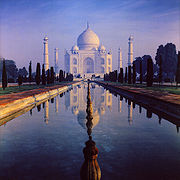- Maqsurah
-
Arab World 
This article is part of the series:
Arab CultureCalligraphy- Architecture
- Textiles
- Khayameia
- Arabic Rugs
- Prayer rug
- Black Stone

Part of a series on
Islamic culture
Architecture Arabic · Azeri
Indo-Islamic · Iwan
Moorish · Moroccan · Mughal
Ottoman · Persian · Somali
Sudano-Sahelian · TatarArt Calligraphy · Miniature · Rugs
Dress Abaya · Agal · Boubou
Burqa · Chador · Jellabiya
Niqab · Salwar kameez · Taqiya
kufiya · Thawb · Jilbāb · HijabHolidays Ashura · Arba'een · al-Ghadeer
Chaand Raat · al-Fitr · al-Adha
Imamat Day · al-Kadhim
New Year · Isra and Mi'raj
al-Qadr · Mawlid · Ramadan
Mugam · Mid-Sha'ban
al-TaiyyabLiterature Arabic · Azeri · Bengali
Indonesian · Javanese · Kashmiri
Kurdish · Persian · Punjabi · Sindhi
Somali · South Asian · Turkish · UrduMaqsurah (Arabic مقصورة) (literally “closed-off space”), an enclosure, a box or wooden screen near the Mihrab or the center of the qiblah wall, which was originally designed to shield a worshiping ruler from assassins.[1] The imam officiating inside the maqsurah typically belonged to the same school of law to which the ruler belonged.[2]
There also may have been some spiritual connotation similar to the chancel screen in churches. They were often wooden screens decorated with carvings or interlocking turned pieces of wood (mashrabiyya).[3]
Historically, it was first innovated by Muawiya I, Umayyid caliph, in Umayyad Mosque. The Companions Mihrab belonged to the Maqsura of the Companions.[4]
References
- ^ Maqsurah an article in encyclopedia Britannica Online
- ^ Gibbs, H.A.R. The Travels of Ibn Battuta (Munshiram Manoharlal, 1999) p127
- ^ Dictionary of Islamic Architecture
- ^ The Great Ummayad Mosque
Categories:- Arabic loanwords
- Islamic architecture
- Arabic architecture
- Mosque architecture
- Architectural elements
- Arabic words and phrases
- Islam stubs
- Architecture stubs
Wikimedia Foundation. 2010.
